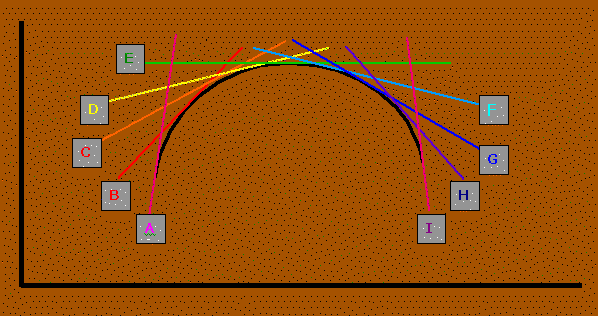|
Students
should be able to visually analyze linear and non-linear graphs
|

| Reading the
Slopes of
Concave and Convex Curves |
In so far as the statements of geometry speak about reality, they are not certain,
and in so far as they are certain, they do not speak about reality.
|
Students
should be able to visually analyze linear and non-linear graphs
|

The fundamental difference between using
linear graphs as models and using curves as
models is that curves
provide more information because their slope changes at every point.
Lines have unique slopes that provide two
pieces of information. First, they show the trade-off,
or rate of
(ex)change, between the independent and dependent variables. Second,
they
illustrate whether the relationship or trade-off is negative ("
inverse") or positive ("direct").
Since the slope of a line is constant, we
know there is no change in the relationship between
the two variables. The relationship between the two variables
does not change over a range of conditions.
Two Types of Curves
In economics we
use two types of curves to represent the changing relationships or
changing tradeoffs: concave curves and convex curves. A graph is
concave if it is bowed upward with the opening facing the origin or the
horizontal axis. It is convex if it is bowed downward with the opening
facing up or away from the origin. In economic modeling, especially at
the introductory level, we assume that all curves are "well-defined",
and "well-behaved", which essentially means that they are all
smoothly-curved, no corners, no flat spots, no dips, no pointed peaks.
Thus, if you have any number of separate points they should all be on a
smooth curve.
(NOTE: The terms concave and convex are
not used uniformly across the disciplines of physics, mathematics, and
economics. The reason for this is that historically the terms were used
first to describe the shape of lenses, which actually have 2 surfaces.
Lenses have both a convex surface and a concave surface. Thus, in
mathematics it is common to refer to a curved surface as either convex
up or down, or even concave up or down. However, the good news is that
in economics we are internally consistent.)
Concave and convex curves also illustrate
the trade-offs and the direction (or sign) in the relationship
between the variables. However, since the slope changes at every
point on
concave and convex curves, the relationship or interaction
between the variables does change continuously. The slopes of curves
illustrate the "acceleration or deceleration" of the interaction
between the variables. That is, the changing slope along a curve
tells us whether the existing conditions are:
i. increasing at an increasing rate;
ii. increasing at a decreasing rate;
iii. decreasing at an rate decreasing;
iv. decreasing at a increasing rate.
The slope of the concave curve above along Tangent Line A is positive, with the vertical variable changing far more rapidly than the horizontal variable. The value of the slope approaches Positive Infinity, +ƒ.
As we move from left to right, along the curve, the slope remains Positive, but becomes continuously smaller, appoaching 0, zero as the Tangent Lines B, C, and D become flatter. Along this arc of the curve the horizontal variable begins to accelerate and change faster than the vertical variable which decelerates in contrast.
Along Tangent Line E the slope of the curve is 0, zero, at the peak, or maximum point. Here the vertical variable does not change at all, as the horizontal variable changes.
Continuing to move along the curve to the right the Tangent Lines F, G, H, and I become increasingly negative, with the horizontal variable first rising rapidly as the vertical variable falls slowly. Then as the vertical variable begins to fall more rapidly, the horizontal variable increases more slowly. At Tangent Line I the value of the slope is approaching Negative, -ƒ.
|
|
![]() Have
a question? Send me and e-mail at martinezp@lanecc.edu
Have
a question? Send me and e-mail at martinezp@lanecc.edu
This webpage was created solely by Phil Martinez
and is copyright by Phil Martinez and Lane Community College.